Looks like World Fintech is on the cusp of a significant transformation in 2025 and beyond, with projections indicating a robust growth trajectory fueled by technological advancements, changing consumer behaviors, and evolving regulatory frameworks. As the financial landscape continues to shift, the fintech market is expected to play a pivotal role in reshaping traditional financial services, enhancing accessibility, and driving innovation across various sectors.
Market Size and Growth Projections
The fintech market, which encompasses a broad range of financial services and technologies, is currently valued at approximately $167.54 billion. This figure is expected to surge as the industry grows at a compound annual growth rate (CAGR) of 25.18%, potentially surpassing $400 billion by 2027 and reaching $514.9 billion by 2028. These projections reflect a significant increase from an estimated $105.41 billion in 2021, demonstrating the rapid adoption of fintech solutions by consumers and businesses alike.
Key drivers of this growth include the increasing reliance on digital payment solutions, the rise of neobanks, and the integration of advanced technologies such as artificial intelligence (AI), blockchain, and data analytics. The COVID-19 pandemic has further accelerated this trend, as consumers and businesses have had to adapt to remote and contactless transactions, leading to a surge in demand for fintech services.
Key Trends Shaping the Fintech Landscape
Several trends are emerging as critical factors in the evolution of the fintech industry. These include:
1. Digital Payments Revolution
The digital payments segment is experiencing unprecedented growth, with consumers increasingly opting for mobile payment solutions and digital wallets for everyday transactions. The global digital payments market is projected to reach $8.49 trillion in transaction value by 2022, highlighting the shift away from traditional cash-based transactions.
2. Rise of Open Banking
Open banking is transforming the financial services landscape by promoting transparency and innovation. By allowing third-party developers to access financial data through application programming interfaces (APIs), open banking enables the creation of new financial products and services that cater to the evolving needs of consumers. This shift is expected to enhance competition among financial institutions and improve customer experiences.
3. Cross-Border Payments Growth
The demand for efficient and secure cross-border payment solutions is on the rise, driven by globalization and the need for seamless international transactions. The wholesale cross-border payments market is projected to reach $225 trillion by 2030, with fintech companies playing a crucial role in enhancing the efficiency of these transactions through innovative solutions.
4. Regulatory Evolution
As the fintech industry continues to expand, regulatory frameworks are evolving to accommodate new technologies and business models. Governments and regulatory bodies are increasingly focusing on creating a supportive environment for fintech innovation while ensuring consumer protection and data security. This regulatory landscape is expected to foster collaboration between fintech companies and traditional financial institutions, further driving market growth.
World Fintech Market Projections
Key Players in the Fintech Market
The fintech landscape is populated by a diverse array of companies, ranging from startups to established financial institutions. Some of the key players in the market include:
- Visa (US)
- Mastercard (US)
- Ant Financial (China)
- Tencent (China)
- PayPal (US)
- Stripe (Ireland)
- Square (US)
- Revolut (UK)
- Klarna (Sweden)
- Nubank (Brazil)
These companies are leveraging advanced technologies to provide innovative financial solutions that cater to the needs of consumers and businesses in an increasingly digital world.
Regional Market Breakdown
The fintech market is witnessing significant growth across various regions, with the Americas leading in terms of market share. However, Europe, the Middle East, and Africa (EMEA) are rapidly catching up, driven by advancements in technology and increasing digital adoption. The Asia-Pacific region is also emerging as a key player, fueled by robust infrastructure developments and a growing consumer base.
Americas
The Americas hold a substantial portion of the global fintech market, benefiting from a well-established technology infrastructure and a supportive regulatory environment. The region is home to numerous fintech startups and established players, driving innovation and competition within the industry.
Europe, Middle East, and Africa (EMEA)
The EMEA region is experiencing a surge in fintech activity, with various countries implementing initiatives to foster innovation and support the growth of fintech companies. The rise of open banking and regulatory support are key factors contributing to the region's rapid growth in the fintech space.
Asia-Pacific
The Asia-Pacific region is witnessing significant advancements in fintech, driven by increasing smartphone penetration and digital adoption. Countries such as China and India are at the forefront of this growth, with a burgeoning fintech ecosystem that includes payment solutions, lending platforms, and investment services.
Future Outlook
As the fintech industry continues to evolve, several factors are expected to shape its future trajectory. The integration of advanced technologies, such as AI and blockchain, will enhance the efficiency and security of financial services, while the ongoing shift towards digital solutions will further drive consumer demand for fintech offerings. Also, the regulatory landscape will play a crucial role in determining the pace of innovation within the industry. As governments and regulatory bodies seek to balance the need for consumer protection with the desire to foster innovation, fintech companies will need to navigate an increasingly complex regulatory environment. In summary, the global fintech industry is poised for significant growth as it approaches 2025 and beyond, driven by technological advancements, changing consumer behaviors, and evolving regulatory frameworks. With a diverse array of players and a rapidly expanding market, the fintech sector is set to reshape the financial services landscape, offering innovative solutions that cater to the needs of consumers and businesses in an increasingly digital world.

